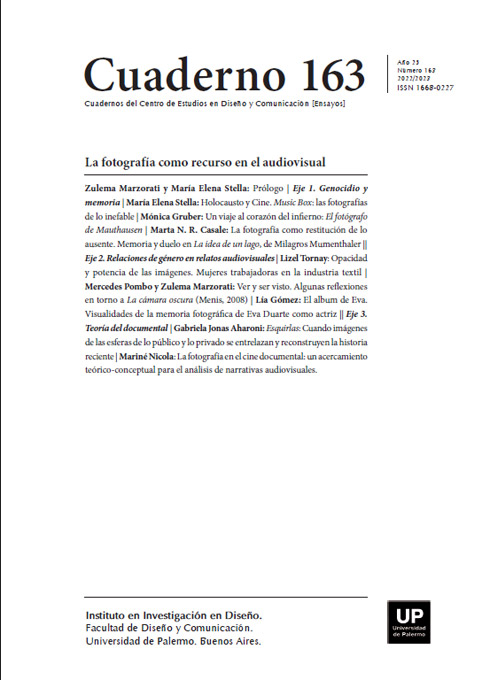Opacidad y potencia de las imágenes. Mujeres trabajadoras en la industria textil
Abstract
Photography provides an indication of “that was” (Barthes, 1982) in film narration, beyond its fictional o documentary nature. However, sits treatment requires specific methodological precautions if it is a documentary production of historical themes. This work will analyze the use of frames and photographs in the documentary film De Alpargatas. Work Stories (Fernando Álvarez, 2009). It is an investigation around themes not addressed by works written at the time of making this film: the daily work and union participation of women factory workers crossed by gender tensions imposed by hegemonic representations. The analysis will focus on frames from Leaving the Lumière Factory (1895) and an advertising film for the Alpargatas Company (1969). From the photographic corpus included en this production, some images founded in the GeneralArchive of the Naation and in the Panorama de Alpargatas Magazine edited by the Company, will be analyzed. The possibilities offered by the images as “luminous traces” (Debois, 2008) and the necessary specific precautions taken, in this case, by the cinematographic narration will be especially considered. In this way, the impossibility of “purity” of the images will be analyzed through the voices of the workers.
References
Barthes, Rolland (1989) La cámara lúcida. Notas sobre la fotografía, Barcelona, Paidós.
Berger, John (2005) Mirar, Buenos Aires, Ediciones de la Flor.
Crary, Jonathan (2008) Las técnicas del observador. Visión y modernidad en el siglo XIX. Murcia, CENDEAC.
Comolli, Jean Louis (2009) Cine contra espectáculo Buenos Aires, Manantial.
De Certeau, Michel (1995) La toma de la palabra y otros escritos políticos, México, Universidad Iberoamericana.
Di Tella, Torcuato (1993) “La Unión Obrera Textil, 1930-1945”, en revista Desarrollo Económico, vol. 33, nº 129, abril-junio.
Deslandes, Jacques (1966) Histoire comparée du cinéma, Vol. I, Bruselas, Casterman.
Dubois, Philippe (2008) El acto fotográfico y otros ensayos, Buenos Aires, La Marca Editora.
Farocki, Harun (2003) Crítica de la Mirada, Buenos Aires, V Festival de Cine Independiente de Buenos Aires, p. 33.
Guinzburg, Carlo (2013) Mitos, emblemas e indícios, Buenos Aires, Prometeo.
Gutiérrez, Leandro y Korol, Juan Carlos (1988) “Historia de empresas y crecimiento industrial en la Argentina. El caso de la fábrica Argentina de Alpargatas” en revista Desarrollo Económico, vol. 28, nº 111, oct.-dic.
Horkheimer, M., Adorno, T. (1970) Dialéctica del iluminismo, Buenos Aires, Sur.
Lobato, Mirta Zaída (2007) Historia de las trabajadoras en la Argentina (1869-1960),Buenos Aires, Edhasa.
Marin, Louis (1993) Des pouvoirs de l’image, París, Minuit.
Marin, Pierre (1999) Poderes y límites de la representación, Buenos Aires.
Mirzoeff, Nicholas (2003) Una introducción a la cultura visual. Barcelona, Paidos.
Oubiña, David (2009) Una juguetería filosófica. Cine, cronofotografía y arte digital, Buenos Aires, Manantial, pág. 83.
Rancière, Jacques (2004) “Lo inolvidable” en Gerardo Yoel (comp.), Pensar el cine 1. Imagen, ética y filosofía, Buenos Aires, Manantial, pág. 171.
Wajcman, Gérard, (2001) El objeto del siglo, Buenos Aires, Amorrortu, 2001.
Los autores/as que publiquen en esta revista ceden los derechos de autor y de publicación a "Cuadernos del Centro de Estudios de Diseño y Comunicación", Aceptando el registro de su trabajo bajo una licencia de atribución de Creative Commons, que permite a terceros utilizar lo publicado siempre que de el crédito pertinente a los autores y a esta revista.


